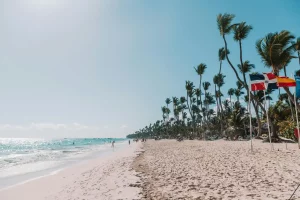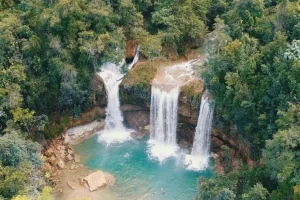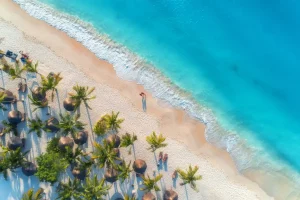Are you ready for an encounter with nature? Indeed, it will leave you breathless. The Dominican Republic is a Caribbean paradise. In fact, it is much more than white-sand beaches. It is a true ecological treasure. It is home to an impressive fauna. You can find native animals of the Dominican Republic here. You will not find them anywhere else.
We know you seek unconventional travel experiences. For this reason, we invite you to immerse yourself in the experience. You can explore this island’s unique biodiversity.
We will guide you through a fascinating exploration. It will cover the native animals of the Dominican Republic. Here, we will detail endemic and representative species. You will learn their traits and habitats. So, prepare for an adventure. It combines exclusivity and well-being with respect for the natural environment.
The most fascinating native animals of the Dominican Republic
The island of Hispaniola is shared territory. The Dominican Republic and Haiti are both here. In fact, it stands as a biodiversity hotspot. It has an impressive number of endemic species. When you visit, you can observe native animals of the Dominican Republic. They do not exist anywhere else on the planet.
Exploring this fauna is a form of ecotourism. For instance, it connects you with the local ecosystem and culture. The richness of its nature is a living testament to its beauty. It speaks of the island’s geological history. Furthermore, its isolation allowed evolution to follow an exceptional course.
The Hispaniolan solenodon, a living relic
Without a doubt, this is one of the most unique creatures. It is one of the lesser-known native animals of the Dominican Republic. This insectivorous mammal has a prehistoric appearance. It is among the oldest species on the planet. In fact, it has survived the extinction of the dinosaurs.
Scientists know it as Solenodon paradoxus. It is the only Caribbean mammal with venomous salivary glands. Interestingly, it inherited this trait from its ancestors. It has a long, flexible snout. Its fur is coarse. Its claws are strong. It uses them to dig for insects and worms.
This nocturnal, solitary animal plays a vital role. For example, it helps with pest control. It also supports soil health. The solenodon is a jewel of Dominican biodiversity. However, it is in danger of extinction. This is mainly due to habitat loss. It is also due to predation by introduced animals, such as dogs and cats.
Currently, conservation efforts focus on creating nature reserves. They also focus on educating local communities. This helps protect this amazing species.
The manatee, the gentle giant of the Caribbean
Here is another one of the native animals of the Dominican Republic. This creature will steal your heart. It has a calm nature and slow movements. People know it as the “sea cow” of the Caribbean. These herbivorous aquatic mammals inhabit coastal waters. They also live in the island’s estuaries and lagoons.
They feed on algae and other marine plants. Consequently, their herbivorous diet helps maintain the health of seagrass beds. These beds, in turn, serve as habitats for many different species.
Spotting a manatee in its natural environment is a peaceful experience. It is also a very memorable one. But this is not just about seeing a top creature. It is about more than the main native animals of the Dominican Republic. In fact, its presence indicates a healthy marine ecosystem. This country has sanctuaries and protected areas. For instance, the Marine Mammal Sanctuary is one such example. There, you can:
- Observe these gentle giants responsibly.
- Learn about their conservation.
- Understand the importance of protecting their habitats.
- And also learn about threats like pollution and boat collisions.
In this regard, Homebelike offers you a unique opportunity. You can experience sustainable tourism. This directly supports these protection efforts.
The American crocodile, king of the mangroves
The Crocodylus acutus is one of those impressive creatures. It is one of the native animals of the Dominican Republic that commands respect. Contrary to its name, it lives in various areas of the island. For example, you can find it in Lake Enriquillo. This is the largest saltwater lake in the Caribbean. It is a unique and essential ecosystem. It is vital for the crocodile’s survival. Its brackish waters and mangroves are ideal. Specifically, this environment is perfect for nesting. It is also great for the growth of young crocodiles.
This large and powerful reptile is a predator. It plays a fundamental role in the ecosystem’s balance. Its presence can be intimidating. However, the American crocodile is a shy animal. It typically avoids contact with humans. For this reason, observing it is a fascinating and safe experience.
A visit to this area will allow you to see them. You can observe these majestic animals in their natural habitat. Of course, you must always keep a respectful distance. The conservation of this ecosystem is essential. It is crucial for the species’ survival on the island.
The hutia, the endemic rodent that survives against all odds
Among the native animals of the Dominican Republic, the hutia is a unique species. Plagiodontia aedium is the most curious and resilient mammal. This large rodent has dense fur. The hutia also has a short tail. Its habitat is primarily wooded and mountainous areas. This rodent is a nocturnal and shy species. Its diet consists of leaves, fruits, and bark. Consequently, it plays a key role in seed dispersal. It also helps with forest regeneration.
The hutia has survived the pressure of introduced predators. These include mongooses and dogs. In parallel, it has resisted habitat loss from deforestation. It is harmless to humans. However, people have historically hunted it. This has reduced its population. It is now listed as an endangered species. In fact, its conservation depends on forest protection. It also depends on captive breeding programs.
Observing a hutia in the wild is a true privilege. Moreover, it represents a direct link. It connects to the island’s natural history. It shows life’s ability to adapt to changing environments.
Native animals of the Dominican Republic: endemic birds
The Dominican Republic is a paradise for birdwatchers. Without a doubt, it is a sanctuary of winged biodiversity. Many endemic species color the island sky.
The avian diversity here is awe-inspiring. It is as impressive as the other native animals of the Dominican Republic. In truth, each of these birds tells a unique story. The country is home to over 300 species of birds. Over 30 of them are endemic to the island of Hispaniola.
The richness of its avifauna is due to its varied ecosystems. Among them are:
- Cool and misty mountain forests.
- Arid zones in the south.
- Vital coastal wetlands.
The diversity of habitats provides the perfect setting. It allows these birds to develop and thrive. It also supports other native animals of the Dominican Republic that inhabit the area. Below, we talk about some of these birds.
Cigua Palmera (Dulus dominicus)
Experts consider this the national bird of the Dominican Republic. This species is a symbol of the country’s natural heritage. You can find it in large colonies. They build communal nests in royal palms. This is a spectacle of social and architectural engineering.
Its song is a constant melody. It resonates in the fields and cities. In short, it symbolizes Dominican rural life. Its gregarious behavior is interesting. The complexity of its nests is also notable. Overall, this makes it one of the most interesting birds to observe.
Native animals of the Dominican Republic: Barrancolí
Small but striking, the Broad-billed Tody is a treasure. The (Todus subulatus) is one of the island’s most unique winged gems. This bird has vibrant colors. It combines emerald green on its back with a white chest. Additionally, it has a touch of red on its throat. The tody inhabits humid forests, thickets, and areas near rivers. Notably, its small size and rapid flight are remarkable. These agile movements make it a challenge. For enthusiastic birdwatchers, this is especially true.
The Broad-billed Tody is among the top native animals of the Dominican Republic. It gets its name from its nests. It builds them in cavities on slopes or earthen walls. Furthermore, it feeds mainly on insects and small prey. It catches them with astonishing precision.
You can still find it in various parts of the island. However, the conservation of its habitats is fundamental. This ensures that this feathered jewel continues to brighten the landscapes. It does so with its presence and subtle song.
Cotica (Aratinga chloroptera)
Do you want to know another vital creature? It is one of the native animals of the Dominican Republic. Then, you won’t want to miss this bright green parakeet. It is endemic to the island. Moreover, it is one of the most coveted birds. Ornithology enthusiasts greatly admire it.
Its population is in danger. Despite this, it has managed to survive in protected areas. These areas are of vital importance. They include the population being in danger. Despite this, it has managed to survive in protected areas. These areas are of vital importance. They include Los Haitises National Park and the Sierra de Bahoruco.
Seeing a flock of these parakeets is a rare and fortunate event. Watching them fly over the dense forest is an unforgettable spectacle. Indeed, it is an explosion of color and life. It will remind you of the importance of conservation. Each sighting reminds us of the fragility of these ecosystems. It shows the need to protect the native animals of the Dominican Republic.
Native plants of the Dominican Republic: home to wildlife
On the other hand, the island’s fauna would not exist without its environment. The native plants of the Dominican Republic form the basis of the ecosystem, providing food, shelter, and habitat for all the animals.
The flora is as varied as the fauna. It ranges from dense forests to coastal mangroves. It also includes cactus formations in the south. The Dominican Mahogany, for example, is the national tree. It is a species of great ecological and cultural importance.
The preservation of these botanical habitats is vital. It is essential for the survival of the fauna. Therefore, every ecotourism trip contributes to their protection. For more information on the island’s biodiversity, you can visit the Puntacana Ecological Foundation’s website.
Conservation of the native animals of the Dominican Republic
Preserving the local fauna and its habitats is not just a noble goal. Instead, it must become a shared responsibility. Environmental education is a fundamental pillar. So is promoting sustainable tourism. And so is creating protected areas. These actions ensure future generations can marvel at this wealth.
Each of us can contribute significantly. We can do this from our position as travelers. For example, by choosing responsible and ethical trips. And at the same time, by actively supporting local communities. They dedicate their efforts to protecting the island’s wildlife.
Native animals of the Dominican Republic on your next trip
At Homebelike, conservation is an intrinsic value. We passionately believe in a tourism model that seeks pleasure. It also respects and preserves the environment. Our mission is to offer authentic experiences. They are sustainable and connect you with nature.
Unlike a standard rental, our platform goes beyond. We offer you a specialist experience service. This person is in contact with you from the moment you book. They assist you throughout your entire stay. They also note what experiences you want to book.
Are you interested in the native animals of the Dominican Republic? We can create an experience that reflects the country’s essence. We have an inventory in unique destinations. These also combine various attractions. When you plan a trip with us, you are not just choosing luxury. You are also contributing directly to the protection of this fauna.
The Dominican Republic invites you to go beyond the superficial. It asks you to discover its true natural essence. Through exploring the native animals of the Dominican Republic, you connect. You become part of a fascinating conservation story. We encourage you to let us guide you. You can have an unforgettable trip. You will marvel at this exceptional fauna. Discover our ecotourism experiences and start planning your adventure today at Homebelike!
References
- Gobierno de la República Dominicana – Medio Ambiente. (2025). Fauna.
- Oficina Nacional de Estadística. (2025, May 22nd). Infografía Condiciones y calidad ambiental: Ecosistema y biodiversidad República Dominicana – mayo 2025.



